

Wayne Schmidt's Silly Putty Page What it is, how it works, how to make it at home, history and interesting experiments
Whether you call it Silly Putty, Potty Putty (Britain), Tricky Putty, Nutty Putty, or Flubber, this stretchy-bouncy-pliable stuff is as interesting to understand as it is fun to play with. Sit back, relax, and enjoy the following page about what Silly Putty is, how it works, its fascinating history, how to make it at home and several interesting experiments.
What
is Silly Putty?

Regardless of the retail source: an un-named brand from Walmart (above left), the Ja-Ru brand (center), or the original Silly Putty (right) from Binney and Smith, all silly putties are the same material: polymethylsilicane molecules crossed-linked with boron-based molecules, essentially silicone oil mixed with borax.
Polymethylsilicane sounds impressive but it's simply a polymer, a very long molecule consisting of a series of small identical molecules linked end-to-end in a chain, in other words: plastic. Think of it as a piece of spaghetti. A large quantity of these spaghetti-like molecules flow like a liquid because they are able to slip and slide around each other.
But, mix some of this oily liquid with boric acid (almost the same thing as water with a little Borax laundry booster in it) and some of the Borax molecules will stick to the sides of the long plastic molecules and in so doing create bridges (cross-links) between them that mechanically bind them together. Think of the Borax cross-links as pieces of very sticky rice. These rice particles glue the long spaghetti strands together and prevent them from slipping past one another. If there is a small amount of cross-linking the result is a slimy goo the consistency of honey. If the amount of cross-linking is very high these bridges between the long molecules lock everything up and you have a block of hard plastic. But, if the amount of cross-linking is just right the resulting material is soft enough to mold and you have Silly Putty.
So far so good. The spaghetti and sticky rice analogy gives us an idea of what Silly Putty looks like on a molecular level, but that doesn't explain its unusual abilities to slowly flow like a liquid, stretch to incredible lengths, bounce like a rubber ball and shatter like glass if struck with a hammer.

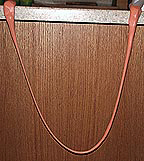
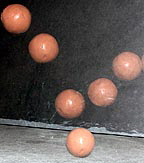
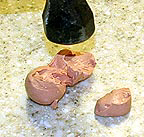
The secret to these contradictory properties lays in the special nature of the Boron cross-links.
Earlier I referred to these cross-links as bridges between the long polymer molecules. That isn't completely accurate because while they do indeed connect the side of one long molecule to another long molecule, they aren't fixed in place like a bridge. Rather, they are dynamic bonds, moving from one connection point to another along the polymer as the thermal motion of their component atoms periodically shake them loose. At a given temperature this migration of cross-link bonds takes place at a fixed rate. At lower temperatures it's slower, at a higher it's faster. A pair of the long polymer molecules can only slide past each other when the cross-linking bonds have temporarily broken free. Similarly, a large mass of such cross-linked material can only flow or be stretched at time scales that are slower than the time scale of the cross-link bond break-and-reconnect rate. If you try to stretch or squash the material faster than this, the cross-links slow the ability of the long molecules to slide over one another and the material gets harder. The faster the material is deformed the fewer cross-links are disconnected and the more rigid the material is. At very high deformation rates, snapping it or throwing it at the floor, none of the cross-link bonds have time to disconnect and the material is locked up solid: it snaps in two or bounces. Taken to the extreme, smashing it with a hammer, causes the material to shatter. (Its behavior of mechanical properties changing in response to deformation rates places Silly Putty in the family of non-Newtonian fluids or dilatant compounds.)
Silly putty is made from mixtures of the two principle compounds at concentrations, mixing rates and mixing durations so that at room temperature, when manipulated at normal human-hand articulation speeds (1-inch per second) it feels soft and pliable. This corresponds to a slow squeeze of the hand. At higher speeds, suddenly squashing it between two fingers as fast and hard as you can (around 3-inches per second) the texture feels more like that of a rubber ball. Faster still, place it on a table and pound it with a fist (12-inches per second) and it feels like hard rubber and doesn't yield at all. Place it in a freezer and it gets stiffer. But note: it doesn't freeze because there is no phase change to a rigid solid. It just gets harder to deform because the lower thermal energy in it means the atoms of the cross-link bonds aren't as active and the cross-links don't migrate as fast. Warm it and the reverse happens: it flows easily at higher deformation rates and may even "splat" instead of bounce if dropped from a short distance.
The reason Silly Putty seems so, well... silly is that its dilatant behavior is contrary to everyday experience. If you throw a ball twice as hard you expect it to travel twice as far. Push twice as hard on a weight and it moves twice as fast. Silly Putty does the opposite: push on it twice as hard and it deforms slower.
Silly Putty isn't unique. A thick mixture of cornstarch and water behaves the same: move slowly and it can be stirred easily, pound it suddenly and it locks up into a dry solid. There are many such materials in existence. Dilatant compounds are even being explored by the military as a possible material for bullet-resistant armor that would be flexible enough of the wearer to move freely yet would lock up if something traveling fast, like a bullet, struck it. But back to Silly Putty.
Where
did Silly Putty come from?
Time line history:
1943: Scottish engineer James Wright working for G.E. to develop a substitute for natural rubber combines silicone oil and boric acid. Silly Putty is born, though it wasn't named that until much later. Wright refers to it as nutty putty because of its ability to stretch into incredibly long. thin strands. (Some references claim it was developed independently at the same time by Earl Warrick at Dow Corning.) G.E. sends samples to engineers around the world trying to find a use for it. No one does.
1949: Ruth Fallgatter, owner of the Block Shop Toy Store, comes across it and asks her marketing consultant Peter Hodgson to add it to her new catalog. At $2.00 per ounce it is the catalog's second-best seller, yet Ruth decides to drop it.
1950: Hodgson thinks it could be his big chance and although already $12,000 in debt, borrows another $147 to purchase a large quantity of it. He markets 1-ounce quantities in small eggs as Silly Putty. Starts selling in February of 1950.
1950, August: The New Yorker magazine publishes a story about Silly Putty. Orders for Hodgson's Silly Putty go through the roof.
1957: Silly Putty is marketed directly to children through a series of ads featured on the Howdy Doody television show. (Prior to this adults had been the primary market.)
1961-61: Silly Putty is discovered by the Soviet Union, Germany, Switzerland, Netherlands, and Italy.
1968: Silly Putty goes to the moon on Apollo 8. It's used to secure tools to bulkheads.
1976: Peter Hodgson dies leaving a net worth of $140 million.
1977: The Binney and Smith company acquires the rights to Silly Putty.
1987: Although sales were always good, in 1987 there is a resurgence in interest in Silly Putty and world wide sales top 2,000,000 eggs a year.
2005: A Silly Putty exhibit is installed in the Smithsonian Museum.
Interesting
Facts:
Silly Putty has a density of 1.17, slightly heavier than water.
Set on fire it burns with a bright white flame that burns slowly. (At least I've read this in several Internet references. I tried it and couldn't get it to ignite, in spite of holding a flame on it for over three minutes. I also tried stretching it into thin threads to see if they would catch fire easier. They didn't. All I got for my trouble was a few brief and tiny flickers of flame that went out in a second or so. Exposed to flame, my Silly Putty bubbled a little and broke down into a whitish mass. (Caution: I don't know what harmful chemicals might be given off by burning or attempting to burn Silly Putty. I did it outside where a draft carried any fumes away from me. I don't recommend anyone repeating this experiment.)
Dow Corning sells the base material for Silly Putty in 50-pound lots under the name 3170 Dilatant Compound. (Smaller bulk quantities can be purchased on-line from several sources.) All the Silly Putty in the world is made from the Dow Corning product. The only differences are in the additives and colorants incorporated into it. For example, Binney and Smith add some type of filler to make it a little stiffer. Ja-Ru doesn't, or at least doesn't add as much, and as a consequence tends to be softer and sag thinner, as the following picture shows:

Ja-Ru brand of
Silly Putty is on the left and
Binney and
Smith putty is on the right. Both
were formed
into spheres and allowed to sag
for the same
period of time.
Immediately after mixing, Silly Putty is clear or slightly yellow. After a week of aging it turns white. Colors are added later.
Silly Putty has a shelf life of 24 months. (But no source I researched could tell me what happens after this time.)
Psychiatrists have found that moulding Silly Putty in one hand as you work or relax is an effective method of reducing stress. I've tried it and it works. Although I'm not a psychiatrist, I theorize that the reason is that it quickly becomes an unconscious activity that occupies some of your subconscious thought processes. If the subconscious is busy with a simple, non-threatening activity it can't work itself into a frenzy trying to resolve a more troubling problem haunting some darker corner of your mind. (Actually, I've found that the softer, homemade Silly Putty works better for this.)
Most retail Silly Puttys comes in 7 main colors: coral (a fleshy-pink), blue, magenta, yellow, orange, gold (actually translucent with fine gold-colored glitter), greenish-yellow glow-in-the-dark, and a color-changing putty that alters its color depending on its temperature. Below are some of the most commonly available shades:
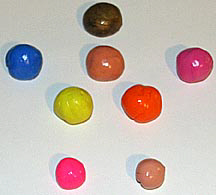
The six on the top are original Silly Putty by Binney and Smith. The two on the bottom are by Ja-Ru and are slightly different shades: the coral is pinker and the magenta is brighter. For a much wider range of colors I recommend visiting the Thinking Putty site at http://www.puttyworld.com/products.html. They sell 1/5-pound tins of it for $8 to $9 dollars. They offer four different glow-in-the-dark colors alone! The following picture is of their amber glowing putty:
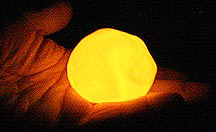
It's a testament to the sensitivity of the human eye that the glow from this putty appears quite bright, yet to capture this image of it I had to make a 10-second exposure at ISO 3200.
Even more interesting about this glow putty is that it is faintly triboluminescent, meaning that when it's discharged you can see a flash of light when it it is quickly stretched or torn in half. This phenomenon is similar to the flash seen when a wintergreen lifesaver is crushed. (Please check out the WINTERGREEN LIFESAVER FLASH page to see what this looks like.) The flash given off by glow-in-the-dark Thinking putty is extremely faint, requiring an ISO of 3200 and two stacked 100-percent contrast enhancements to make it even faintly visible in a photograph. Such as it is, here it is:

The faint, oblong grayish blob extending from the lower left to upper right corner is the open, freshly torn face of Thinking Putty that was clamped between two boards before ripping in half. In comparison, the flash from a wintergreen lifesaver is ten times as bright. As hard as it was to capture this flash, it is easily seen in person.
Silly Putty is sold in 0.47-ounce quantities, in 2006 most often in 2-packs. Off-brand companies also offer 2-pacts at cut-rate prices but usually the quantity of putty per egg is reduced to 0.18-ounces so the cost per ounce is really very close.
While Silly Putty can still be used to pick up black newsprint and black-line images off newspapers, the colored inks used in the comics section have changed and you can no longer lift such images and stretch them into funny faces. However, faces printed in black still transfer nicely:

And you can still pull the faces into odd shapes:

The reason this works is that while the color images use true inks that are absorbed by the paper and adhere to it, print and black-line images are printed with a mixture of oil and lamp black (finely powdered carbon black.) The result is that the black powder that creates the letters and pictures is only mechanically connected to the surface of the paper. When blotted with Silly Putty it comes off.
If warmed in a microwave it turns thinner and sticky, then returns to normal as it cools.

Most references report that when bounced it bounces back to 80-percent of the height it was dropped. This is halfway between a standard rubber ball and a superball. (My tests only average 60-percent, but then I may not have made perfectly round spheres.)
I have read two reports of people dropping a large ball of Silly Putty from a tall building and that after bouncing up from the first impact, it shattered when it hit on the second. Perhaps the first impact was enough to create a myriad of small fractures, but not quite enough to shatter it. These cracks didn't have time to heal before the second impact, which was enough to finish the job.
Because there is no water in Silly Putty it will never dry out, unlike homemade formulations.
In spite of its stretchability, Silly Putty can be easily torn. Squash it down so that it's 1/4-inch thick, hold it close to the upper edge in both hands, use the nail of one thumb to create a sharp crease at the edge, immediately rip it in half starting at the crease by sharply twisting one hand at the wrist. The putty should tear cleanly in half.
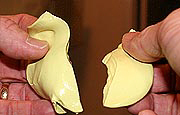
Silly Putty is classed as a visco-elastic material, something half way between a liquid and a solid.
While many sources state that Silly Putty can be shattered by hitting it with a hammer, it's not as easy as it sounds. Even chilled in a freezer it takes a good, hard whack to get it to break. Placing it on a very hard and solid surface, like a concrete slab, also helps.
UPDATE!!! While silly putty is usually just tacky as regards its ability to stick to things, I've discovered two materials it instantly bonds to and is very difficult to remove. One is Canon Photo Pro glossy printer paper. The lightest touch and it's almost impossible to get off. Other glossy photo papers, like JetPro, don't do this. Another instant-bonder is a prescription card I received. I assume that these two items have a silicon or silicon-like compound in them that bonds with the silicon in silly putty.
NEW!!! Another phenomenon I'm looking into is that when kneaded for a long time it seems that a black soot-like material builds up on my finger under my gold wedding band. I find it hard to believe that the gold is reacting with the silly putty because gold is one of the least reactive elements in the world.
How
to make Silly Putty at home:
Making a Silly Putty-like substance at home is quick and easy using everyday materials.
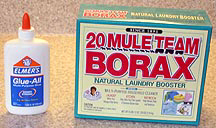
I studied many recipes from the Internet and experimented with them. The following is the easiest, quickest and most reliable:
Mix one tablespoon of Borax into 4 cups of warm water in a dark bowl. You want the liquid 3 to 4-inches deep. (The warm water just helps the Borax dissolve faster. It doesn't affect the reaction. The exact amount of Borax isn't critical. Anything from half a tablespoon to two table spoons works. Using a dark-colored bowl is simply to make watching the glue enter the water easier.)
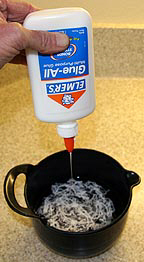
Slowly drizzle Elmer's white glue (Elmer's white school glue works the best) into to water, moving around so the strands are spread around. (I found that a great way to do this is to stir the water so that it's swirling around clockwise in the bowl. Then drizzle the glue in at one spot. The moving water will carry the stream away so you don't get a clot that might not mix well. The swirling water will automatically carry the strands to the center of the bowl. Drizzle from about 18-inches above the surface of the water so that the stream has enough speed to punch down through the surface. Otherwise surface tension may trap it on the surface and slow the reaction.
The reason you want a thread-thin stream of glue entering the water is that for the Borax to mix with the glue and convert it to Silly Putty it needs to penetrate into it. The more surface area is exposed to the Borax solution the faster and more complete the reaction will be. Several on-line references stated that you can just pour a glob of the glue into the Borax and stir it up. What I found is that there are always pockets of unreacted glue inside the putty which ooze out while kneading it. It's messy and time consuming to put this mess back in the solution and kneed it underwater until all the glue (hopefully this time) has been converted.
I used Elmer's standard white glue, Elmer's white school glue, Elmer's clear (actually it's a pale aqua) school glue and an off-brand white school glue. The Elmer's white school glue was by far the best, producing a pliable, stretchy, bouncy material that was the closest to real Silly Putty. Elmer's All-Purpose white glue produced a harder putty that tore instead of stretched. Elmer's clear school glue made an attractive, clear, aqua-colored putty that crumbed very easily. The off-brand white school glue made a putty that was to soft yet, oddly, also tended to tear instead of stretch.
If all you have is Elmer's All-Purpose white glue, adding 1/4 to 1/2 teaspoon of water to 2 tablespoons of glue and mixing it together before drizzling it into the Borax water will greatly improve the texture of the resulting putty, though it still won't be quite as good as that made with Elmer's white school glue. Adding 1/4-teaspoon of water creates a putty very close to Silly Putty in texture. Adding 1/2-teaspoon makes a putty that is slightly softer.
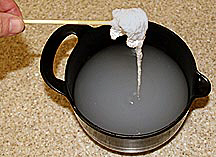
After you've drizzled as much glue into the Borax water as you want, use a swizzle stick or stirring rod to swirl the strands around in the water for a few seconds. The strands will collect on the end of the rod like cotton candy. Pull it out and remove the glob of homemade Silly Putty. Use your hands to squeeze out the water and form it into a solid ball. Use a smooth cloth like a cotton handkerchief to blot it dry (avoid paper toweling - I found the putty sticks to it too aggressively) and you're done!
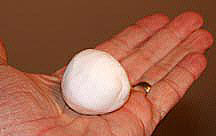
The Silly Putty you just made, assuming Elmer's white school glue was used, will be softer than real Silly Putty, brilliant white, lighter (almost foamy in comparison) won't bounce as well, isn't as sticky, and won't stretch as fast (but pull very slowly and it will stretch very far) but it does indeed feel a lot like the real thing. Left to sit it will slowly flow outward and flatten itself out like Silly Putty. The most interesting thing about this homemade Silly Putty is that after it's left to sit awhile it feels very cool, almost chilly to the touch. The reason is that unlike real Silly Putty, this putty has a lot of water bound up in it. As this water slowly evaporates it cools the putty the same way perspiration cools your face. While interesting, this evaporation has a downside. It means that the glue in the putty is slowly drying. Left out in the open in 24 hours a dry skin will begin to form over it and some of it's characteristics will change. To preserve it place it in a plastic bag or tightly closed Tupperware container that is sized so that the putty completely fills it.
One batch of Borax water is enough to make several golf ball-sized batches of Silly Putty, though because it gets cloudy after the first use I usually mix up a new solution for each batch.

Putty made
from Elmer's clear school glue isn't good for anything,
but it's
attractive to look at.
Chemically, Silly Putty made from Elmer's glue has polyvinyl acetate molecules as the long spaghetti-like molecules instead of polymethylsilicane molecules. The Boron cross-link molecules are essentially the same as in real Silly Putty.
One on-line reference claimed that the texture of homemade putty could be altered by mixing starch into the Borax water. I added 1/4 cup and the resulting putty was identical to the putty made without starch. The same source claimed foamy putty could be made by mixing some baking soda into the Borax water and vinegar into the glue before adding the glue to the water. The idea is that when the two combine the vinegar and baking soda will react and create carbon dioxide bubbles in the putty. I tried it but nothing happened.
Homemade Silly Putty can be colored by mixing a few drops of food coloring into the glue before drizzling the glue into the Borax water.

Don't trust the color to be colorfast. I found that left on a piece of paper for a few minutes a very pale stain was left behind. However, the color didn't appear to be transferred to hands during handling.
I found a book titled Mudworks by MaryAnn F. Kohl that had two alternative recipes for silly putty. The first used one part liquid starch and two parts white glue. When I tried it all I got was a sticky mess even though I measured carefully and mixed for over ten minutes. The second used 1 part toothpaste, 2 parts white glue, 4 parts corn starch and 1 part water. This failed completely when I tried it. It remained a sloppy liquid. Although I was very careful to follow the directions in both cases neither of these recipes worked. Other people may have better luck, but my experiences suggest that these are not nearly as good or reliable as the Borax and school glue recipe.
How
to remove Silly Putty Stains:
Look in horror on every mother's worse nightmare; a large glob of Silly Putty squashed into carpeting and left to soak in for days:

The two removal methods I found differed only in that one used isopropyl alcohol and the other used WD-40 lubricant.
Here's the one for isopropyl alcohol:
1. Use a dull knife or fingernails to scrape away as much of the putty as possible without damaging the underlying fibers. (This is tough because left overnight Silly Putty will flow in between every fiber in the carpeting. Always work toward the center of the glob or you'll end up pushing it from one area to another. I found fingernails worked better than knives or spoons. Once there is enough of a glob to grab, do so and slowly pull it off. Repeat this process to remove as much as possible.)
2. Soak with 95-percent isopropyl alcohol and let sit a few minutes. (The strongest I could find was 91-percent. It worked fine.)
3. Scrape or blot away as much as you can.
4. Repeat the soak-and-scrape/blot process. (By this time I found the putty had been liquefied and blotting/rubbing easily soaked it up.)
5. Spray a third time and wipe (or pinch) up remainder with a cloth.
6. Wash area with water and dish soap to remove any residual stain. (I didn't need to do this. The alcohol didn't leave any stain.)
So, the
alcohol technique worked. I assume it would work even batter on
cloth. I tried a similar technique using WD-40 as recommended by one
reference but it didn't work. Repeated soakings didn't seem to effect
the Silly Putty at all.
Note: always test a small area that's out of sight before attacking the stain. Isopropyl alcohol may remove the color from or dissolve some fibers.
For removing Silly Putty from hair I read several references that claimed that soaking the area with lots of baby oil or hair conditioner and warm water may work. This was one experiment I was reluctant to try.
Experiments
and activities:
Stop tables from rocking: One of the uses I read for Silly Putty is that it is supposed to be good for stabilizing the legs of uneven tables or chairs. I doubted this because I figured it would just squash out of the way or at least flow out overnight. I was wrong. It squashes down and continues to adjust to changing pressures to keep the table or chair from rocking. If pressure is continually applied to the puttied leg it will sag enough so that the table may rock when leaned on in the opposite way if the putty breaks loose, but the putty quickly sags downwards to fill the void and the table is solid again. Usually, the putty's stickiness will adhere it to the floor and bottom of the leg enough so that it ties the leg to the floor preventing it from rocking back. For chairs or tables that are meant to be slid around the putty may drag on the floor until its bottom surface picks up enough dust and dirt to reduce its stickiness. An immediate cure to this problem would be to pat the bottom of the putty with a little flour or cover it with a small piece of plastic, though this may reduce its stabilizing ability.
I got to wondering why the putty doesn't just flow away. I believe there are two reasons.
First, although silly putty does tend to flatten out by itself, it never goes completely flat as it would if it were a pure liquid. Left to sit for weeks it'll still retain a dome shape, which is enough to keep in contact with both the floor and the bottom of the table's foot.

Second, when Silly Putty is in contact with two horizontal surfaces it doesn't eventually break free of the upper surface as one would expect, even if left for days as the following image shows:

I suspect that at some point the flow-resisting forces inside the Silly Putty are as strong as the gravitational forces trying to make it flow down.
Funnel trick: Place a funnel with a large glob of Silly Putty in it on a clear glass. Over the next few days the Silly Putty will very slowly ooze into the glass.
Knife trick: Support a knife sharp-edge upward and place a ball of Silly Putty on it. Over night the putty will slowly cut itself in half, glue itself back together under the knife and continue to ooze down.
A new sport is born: Putty Racing!
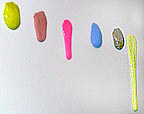
Okay... I admit it, this may be disgusting. But at least it's a sure conversation starter (and possible relationship ender.) Unless you're interested in a multi-place tie, this only works if different brands of Silly Putty are used. The yellow leader in the picture is the non-brand from Walmart, the magenta second place is Ja-Ru brand and the four close ties for third are all original Silly Puttys.
Oh yes, this isn't really much of a spectator sport. It takes hours for even the fastest putty to ooze downward a few inches.
I sincerely hope you enjoyed this page as much as I did putting it together. As I come across other interesting things to do with Silly Putty I'll be sure to add them to the page so please check back often.
Return to homepage to browse 100 other topics: everything from metal detectors and Knitting Nancies to the strange world of lucid dreaming.